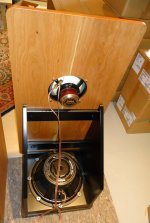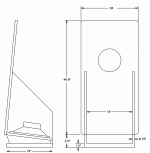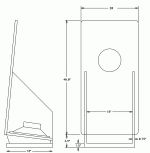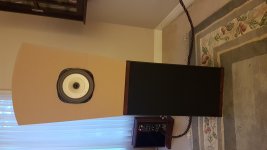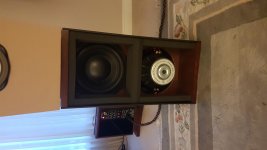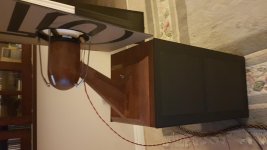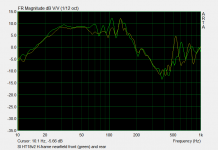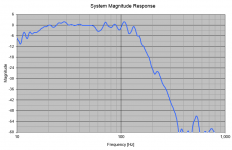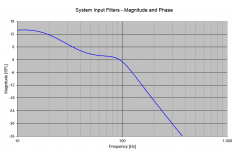I really love the slot loaded bass concept. Right now I've got twin pairs of Goldwood 18 drivers handling the lows and have to say it's such a natural sound.
I don't know, I think it's just the dipole arrangement but perhaps the slot loading has some special quality too- really makes a kick drum or a string bass feel like they are in the room. The slot loading, however allows this speaker to be narrower for increased WAF.
Sorry, here you go.

You might want this also.

Thanks, Nelson! A lot of clever ideas all rolled into one. It takes advantage of the floor image, the slant drops the Q of the first slot mode, the additional height of the LF section is quite modest, and the side baffles give additional LF support for the backwave from the driver. Very elegant!
Hmm ... this could applied to the "Beyond" project. Two side-by-side Altec/GPA 416's, 515's or TAD 1601a's in a curved or delta-front OB, a pair of Eminence Definimax 15" drivers pointing into the slanted slot, and the AH425/Radian 745NeoBe or AH425/18Sound1480A on the top.
The top section would need little or no EQ, while the slot can be driven by its own Class D amplifier and associated EQ.
It certainly cuts down on cabinet costs compared to an Onken W/Pioneer 2401 (with the huge 145 kg/320 lb cabinet), and performance would be similar or better (no cabinet resonances, for one thing).
Attachments
Last edited:
Have had the pleasure of hearing the Pass speakers at the last couple of Burning Amp gatherings. They are indeed quite nice! What Lynn describes would really take them over the top! My own issue seems to always be living in relatively small quarters that don't allow for placing the speaker very far out into the room. I saw and heard some speakers that addressed this by basically making an open top box that sends the back wave up towards the ceiling. I've been thinking of something along the same lines with perhaps an open top version of the Boffle concept. Sorry not trying to steal the thread just sharing my ramblings
Yes indeed.Thanks, Nelson! A lot of clever ideas all rolled into one.
I wonder with the slot loaded bass how much wall loading alters the response. Usually you need some distance from the wall with OB to get proper bass and mid-bass response. The slot loaded woofer might make this design less position sensitive.
And of course Lynn wants to take it to the max with twin 15s and a horn.
if just for bass...
Nelson can you tell me how much of the front baffle is required for the bass driver? If one was not going to use a driver like the Lowther could the front baffle be made any smaller or do the two drivers simply share a common baffle? Thank you for posting about your design. Best regards Moray James.
You might want this also.

Nelson can you tell me how much of the front baffle is required for the bass driver? If one was not going to use a driver like the Lowther could the front baffle be made any smaller or do the two drivers simply share a common baffle? Thank you for posting about your design. Best regards Moray James.
The slot loading help to reduce excursion somewhat, has more punch, but low group delay of an OB. The KaZba is a type of dipole slot loading with much larger bandwidth and deeper bass extension. Check out what CLS has done - over the top dual 18in drivers.
http://www.diyaudio.com/forums/full...-aperture-z-baffle-dipole-19.html#post4355550
http://www.diyaudio.com/forums/full...-aperture-z-baffle-dipole-19.html#post4355550
As you mentioned owning those 18" Goldwoods, have you ever heard MJK’s Jordan/Goldwood passive OBs? Or any other OBs, such as Manzanita Audio Solutions . Products If yes, were they passive or active?Have had the pleasure of hearing the Pass speakers at the last couple of Burning Amp gatherings. They are indeed quite nice! What Lynn describes would really take them over the top! My own issue seems to always be living in relatively small quarters that don't allow for placing the speaker very far out into the room. I saw and heard some speakers that addressed this by basically making an open top box that sends the back wave up towards the ceiling. I've been thinking of something along the same lines with perhaps an open top version of the Boffle concept. Sorry not trying to steal the thread just sharing my ramblings
Or perhaps any of these OBs? Trio15 Open Baffle Speakers
How did you find them compared to the Quad 57s and/or 63s + your sealed Genesis subs? I don’t necessarily mean in the good or bad sense, although perhaps that as well. But in the overall presentation, 3D sound stage size, imaging, detail, highs, midrange, midbass, overall tonality? Why might you prefer Quads over most OBs, or vice-versa?
How difficult would it be to run very satisfying OBs with respectable bass response without DSP kept in the system in a 14 ft x 19 x 8 room?
Sorry to say I haven't heard any of those. I guess sobriety is the realization that no matter how many speakers you hear, you'll just never hear them all, and never under duplicate conditions. MJK's notes inspired me to buy the Goldwoods and I feel I've gotten good value for dollar from them. All those elements of 3D can really be there when you have the right set up with well matched subs and main drivers as good as the Quads. Are they perfect? Is anything? I've had the Goldwoods in a room about the size of yours and wasn't disappointed but to be fair it was a strictly music set up and not trying to do double duty for movies. For the movies I'm happy with my Genesis. On the other hand if I were starting from scratch I think your approach with the Rythmik's are likely to be as good or better than any I've done. And I still don't know why a careful set up of sealed and dipole wouldn't work especially with the sealed unit covering the lowest octave. I can't really comment on DSP as I haven't really had the chance to fully try it. However a decent mike and a real time analyzer (I borrowed one) can help out alot in dialing in your system. Don't forget to have a good time with it all 
The example above was with a 15" Eminence Definimax (my current favorite)
and you can clearly see the peak at around 200 Hz. You definitely want to
be out of there at a frequency lower than that. I cross that system on the
low end at 80 Hz or so at 12 dB/oct, and it meets the Lowther 8" drivers
nicely at about 160 Hz (in phase).
Nelson I know this is old, but I can't find anything different than this slot design, from you. I presently have a PM6A, silver VC, Ticonal magnet in OB with Rythmik OB subs in H frame below. It's good but want to get away from the servo plate amps. Do you have any updates or another OB design? Would an additional 12"-15" on the baffle below the FR driver make any sense for the low mids to mid bass?
Have you done anything with the SAL 08C08 in OB?
Garytr
The example above was with a 15" Eminence Definimax (my current favorite)
and you can clearly see the peak at around 200 Hz. You definitely want to
be out of there at a frequency lower than that. I cross that system on the
low end at 80 Hz or so at 12 dB/oct, and it meets the Lowther 8" drivers
nicely at about 160 Hz (in phase).

Interesting to see this thread pop up. I've been working up a dipole H-frame subwoofer recently and this seems like a good place to share my thoughts about it.
The problem: I have a dipole speaker that needs bass - low bass. This typically means large cancellation losses unless the front-to-back pathlength can be made pretty long. Long pathlength means a rather large plain baffle, or a folded one like a U-frame, H-frame, etc.
My solution: I decided to make an H-frame because its symmetric radiation pattern matches an OB and found an affordable high-excursion 18" driver. To get a relatively long front-to-back pathlength the H-frame is about 30 inches long, and to accommodate the 18" driver it's about 24" wide. With the driver mounted on a baffle placed about midway front-to-back, the front and rear H-frame tunnels form short transmission lines that have a resonant frequency around 150Hz or so. This resonance is like Nelson's slot loaded 15 Definimax in the OB he posted about (ref: his quote above) but the aspect ratio of the t-line is much lower. This is because he uses a slot, while I use a 24"x24" tunnel. As a result the Q of the resonance in my H-frame is pretty low, so low that I can pretty much ignore it altogether. I have some measurements saved on my other computer, and I will post them shortly.
So, this idea of the tradeoff between H-frame overall length, and the aspect ratio of the transmission line, just recently clicked into place for me. It suggests that if you want a dipole with minimal low frequency losses (e.g. for a subwoofer) you need a "long" pathlength. If you use a large driver so that your t-line is also quite wide, the aspect ratio will be relatively low and the Q of the t-line resonance will be easy to deal with or even inconsequential. This is a nice result because you probably want to use a large driver anyway, to get a low Fs and lots of total displacement. A bigger driver really IS better in this case.
There is one problem, however: vibration. The mass of the large cone is not insignificant. When I was doing some impulse testing of my rather wispy H-frame on a wooden floor (so friction is pretty low and mass is low) the whole assembly would move more than 0.5 inchs at the start of the impulse unless I sat on it. I will definitely need to mass load the H-frame with 100lbs+ of sand or bricks but it does seem to be pretty effective at low frequency reproduction so I am willing to do that.
I will post a pic of the prototype and some measurements soon.
Octavia the amps sound good, are clean powerful, if not somewhat inefficient, but they don't always play nice with other pieces. I finally overcame hum, which I still had after an amp mod from Rythmik, by making diy Hum-X ground filters. The hum I am talking about is thru the speakers, not transformer hum. I continue to get some thumps on shut down with certain preamps.
To be clear the bass system is very good, using a PC with a tone generator is flat to 29hz and plays sub 20hz. It is fast and controlled. Here's a couple pic.'s, just playing with idea of acrylic baffles, so forgive cardboard, I have/will make several shapes/sizes for comparison.
Charlielaub H is 13 5/8 w x 281/4h x 13 3/4 d. Wood is 1 1/8 Beech butcher block, side panels are 1/4" 6061 aluminum to keep things narrow with 2 kinds /layers of damping. Dark grey is acoustic foam. Upper baffle is 13 5/8 - 18 w and 24 3/4 high. Hope this helps
Garytr
To be clear the bass system is very good, using a PC with a tone generator is flat to 29hz and plays sub 20hz. It is fast and controlled. Here's a couple pic.'s, just playing with idea of acrylic baffles, so forgive cardboard, I have/will make several shapes/sizes for comparison.
Charlielaub H is 13 5/8 w x 281/4h x 13 3/4 d. Wood is 1 1/8 Beech butcher block, side panels are 1/4" 6061 aluminum to keep things narrow with 2 kinds /layers of damping. Dark grey is acoustic foam. Upper baffle is 13 5/8 - 18 w and 24 3/4 high. Hope this helps
Garytr
Attachments
Here are a couple of additions pics. First is measurements of front and rear raw (unfiltered) response of the H-frame. Next is a system model, from front, with EQ and low pass filtering applied. Last is the magnitude of the filter functions.
Attachments
Here are a couple of additions pics. First is measurements of front and rear raw (unfiltered) response of the H-frame. Next is a system model, from front, with EQ and low pass filtering applied. Last is the magnitude of the filter functions.
Charlie that looks great me thinks!
The last picture seem to miss the phase graph doesn't it, have you done any measurements of total system phase (w & wo EQ'ing)?
Edit: Forgot to ask, what Qts and VAS etc. did your element have?
Last edited:
- Status
- This old topic is closed. If you want to reopen this topic, contact a moderator using the "Report Post" button.
- Home
- Loudspeakers
- Multi-Way
- Novel Open Baffle Construction Techniques
